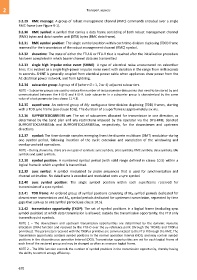Page 680 - 5G Basics - Core Network Aspects
P. 680
2 Transport aspects
3.2.29 RMC message: A group of robust management channel (RMC) commands encoded over a single
RMC frame (see Figure 9-1).
3.2.30 RMC symbol: A symbol that carries a data frame consisting of both robust management channel
(RMC) bytes and data transfer unit (DTU) bytes (RMC data frame).
3.2.31 RMC symbol position: The single symbol position within each time-division duplexing (TDD) frame
reserved for the transmission of the robust management channel (RMC) symbol.
3.2.32 showtime: The state of either the FTU-O or FTU-R that is reached after the initialization procedure
has been completed in which bearer channel data are transmitted.
3.2.33 single high impulse noise event (SHINE): A type of electrical noise encountered on subscriber
lines. It is evident as a single high-power impulse noise event with duration in the range from milliseconds
to seconds. SHINE is generally coupled from electrical power cable when appliances draw power from the
AC electrical power network, and from lightning.
3.2.34 subcarrier group: A group of G (where G = 1, 2 or 4) adjacent subcarriers.
NOTE – Subcarrier groups are used to reduce the number of test parameter data points that need to be stored by and
communicated between the FTU-O and FTU-R. Each subcarrier in a subcarrier group is characterized by the same
value of a test parameter (see clause 11.4.1).
3.2.35 superframe: An ordered group of MSF contiguous time-division duplexing (TDD) frames, starting
with a TDD sync frame (see clause 10.6). The duration of a superframe is approximately six ms.
3.2.36 SUPPORTEDCARRIERS set: The set of subcarriers allocated for transmission in one direction, as
determined by the band plan and any restrictions imposed by the operator via the DPU-MIB; denoted
SUPPORTEDCARRIERSds and SUPPORTEDCARRIERSus, respectively, for the downstream and upstream
directions.
3.2.37 symbol: The time-domain samples emerging from the discrete multitone (DMT) modulator during
one symbol period, following insertion of the cyclic extension and completion of the windowing and
overlap-and-add operations.
NOTE – During showtime, there are six types of symbols: sync symbols, pilot symbols, RMC symbols, data symbols, idle
symbols and quiet symbols.
3.2.38 symbol position: A numbered symbol period (with valid range defined in clause 10.5) within a
logical frame in which a symbol is transmitted.
3.2.39 sync symbol: A symbol modulated by probe sequences that is used for synchronization and
channel estimation. No data frame is encoded and modulated onto a sync symbol.
3.2.40 sync symbol position: The single symbol position within each superframe reserved for
transmission of a sync symbol.
3.2.41 TDD frame: An ordered group of symbol positions consisting of Mds symbol periods dedicated for
downstream transmission and Mus symbol periods dedicated for upstream transmission, separated by time
gaps that sum up to one symbol period (see clause 10.5).
3.2.42 transmission opportunity (TXOP): The set of symbol positions in a logical frame (excluding sync
symbol position) at which data transmission is allowed; outside the transmission opportunity, the FTU only
transmits quiet symbols.
NOTE 1 – The downstream and upstream transmission opportunities are determined by the dynamic resource
allocation (DRA) function and received by the FTU-O over the γO reference point (through the TXOPds and TXOPus
primitives). The parameters received with the TXOPus primitive are communicated to the FTU-R through the RMC. The
transmission opportunity contains symbol positions in the normal operation interval (NOI), and may contain symbol
positions in the discontinuous operation interval (DOI). Transmission opportunities are set for each logical frame of
each line of the vectored group and may be changed as often as once per logical frame.
NOTE 2 – The DRA function controls the number of symbol positions in the transmission opportunity, thereby having
the ability to control energy efficiency.
670

